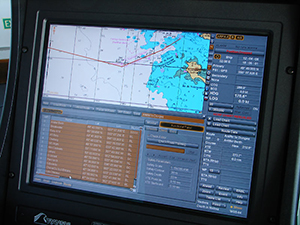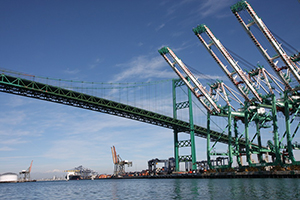When the American Association of Port Authorities (AAPA) convened in New Orleans for their annual convention late last year, the buzz was understandably about presidential campaign promises to invest in infrastructure. And while both candidates promised to make this a priority, President-elect Donald Trump was especially adamant about getting started post-haste in 2017. Now say, port executives, it's time to “put up or shut up.”
“Mr. Trump has put forth an ambitious goal of investing up to $1 trillion to rebuild America's infrastructure, for which freight transportation and ports are vital components,” says AAPA president and CEO Kurt Nagle. “An enhanced focus on freight transportation and ports would certainly help achieve the new administration's goal of building a better economic future for America.” 
Chief among the key recommendations laid out by AAPA is the relief of traffic bottlenecks and the expansion of port capacity. According to Nagle, this can be done by providing additional funding for the Fixing America's Surface Transportation (FAST) Act, which was signed into law in December 2015. The AAPA is also calling upon legislators to create a sustainable freight trust fund to plan and build multimodal projects.
“We must establish a properly funded and staffed Office of Multimodal Freight Transportation within the U.S. Department of Transportation's (DOT) Office of the Secretary,” says Nagle. “We're also supporting funding for a robust ‘StrongPorts' program under the DOT Maritime Administration to help ports plan for their 21st century infrastructure needs.”
Nagle is also championing an increase of investments for authorized marine highway projects to ensure transportation alternatives alongside congested landside transportation corridors [see sidebar]. This would entail and increasing funding for transportation infrastructure grants to $1.25 billion per year.
Most U.S. ports have long been speaking with one voice to modernize and fully maintain federal navigation channels by making harbor maintenance tax (HMT) spending a priority.
“They want to continue the goal toward full use of the HMT by ensuring equity and fairness of distributions by increasing funding maintenance spending in the fiscal year 2018 budget request,” explains Nagle. “This includes funding for donor and energy transfer ports and for devising a permanent solution as part of tax reform or other legislation guarantee all annual HMT revenues are spent.”
State of Freight II defines port needs
The AAPA has reached out to many other stakeholders to forward its agenda. The most outstanding example of this, say analysts, is when it teamed with the American Association of State Highway and Transportation Officials (AASHTO) to develop a new report titled “The State of Freight II—Implementing the FAST Act and Beyond.”
“Besides helping the ports define their goals, this report also develops a baseline of investment needs to build out a 21st century freight network,” says Bud Wright, AASHTO's executive director. “This survey is the second step in identifying the critical freight infrastructure needs of the United States.”
The report identifies baseline investment needs of $29 billion in seaport landside transportation infrastructure project investments over the next decade to keep pace with rising freight volumes and increasing population density in metropolitan areas.
“AASHTO and AAPA released this survey also because the navigable waterways in 38 of the 50 states provide substantial economic benefits to the entire United States,” adds Wright.
David Bernhardt, AASHTO president and Maine DOT commissioner, observes that public and private investment has led to a surge in new business for the Port of Portland, Maine.
“With final grant it needs to launch a $15.5 million improvement project, the International Marine Terminal will double the amount of cargo it can handle now.”
The project will be funded by a combination of federal and state grants, which include a $7.7 million federal freight infrastructure grant, and a $500,000 investment from Pan Am Railways, a private regional railroad.
Since those plans got underway, the “niche” Port of Portland has been able attract scheduled inbound calls from the Icelandic carrier, Eimskip, thereby gaining access to markets in Scandinavia and the EU for high-end perishable freight. Indeed, adds Bernhardt, Portland is now well on the way to competing with Canadian gateways for goods requiring refrigerated shipping and warehousing.
M. Kathleen Broadwater, Maryland Port Administration deputy executive director, and past AAPA chair of the U.S. legislative policy council, notes that the Port of Baltimore is working with CSX to rebuild its rail network and take pressure off of Maryland's highways.
“States are now required to have a state freight plan by December 2017,” she says. “We have been standing still while the ocean carrier industry has been steadily building bigger and faster vessels,” she says. “It's time for us to catch up.”
Digitizing operations on deck
Meanwhile, industry analysts see more individual port investment in “digital infrastructure,” with the most recent example now underway at the nation's largest ocean cargo gateway.
In a stunning example of public/private partnerships, the Port of Los Angeles and GE Transportation are working to pilot a port information portal. This, say industry analysts, is a wholly unique approach to demonstrate the benefits of digitizing maritime shipping data and making it available to cargo owners and supply chain operators through secure, channeled access. 
“The digital platform will provide logistics managers with greater line-of-sight and planning capabilities to more effectively service Mega -container vessels,” says Jon Monroe, a maritime consultant in Los Angeles.
According to Monroe, cargo data used in the two-month pilot project will include filtered information from the U.S. Customs and Border Protection's Automated Commercial Environment (ACE) system. “This becomes especially important as we attract bigger vessels belonging to multiple carrier alliances,” he says.
Monroe believes that the pilot project is a critical first step toward enabling next-level collaboration and coordination among the many stakeholders involved in the conveyance of waterborne cargo containers. Ideally, it will enhance container throughput by delivering fast, data-driven insights through a single portal to partners across the supply chain.
“To keep pace with the rapidly changing shipping landscape, operations at our ports must evolve,” said Gene Seroka, executive director at the Port of Los Angeles. “Digital solutions that enable supply chain partners to receive a ship's cargo information well in advance of arrival, like with the digital portal we're envisioning with GE Transportation, are a critical key to optimizing U.S. cargo efficiency and trade competitiveness.”
Ultimately, the goal of the port information portal is to improve data-flow between beneficial cargo owners (BCOs), ocean carriers and other stakeholders to create an extended window of time to track inbound cargo.
“Having established new metrics, the ports hope to more effectively service vessels, optimize cargo movement and improve the predictability and reliability of the supply chain,” agrees Monroe.
But he and other analysts are quick to add a caveat regarding the dark side of technology: cyber-risk.
“Cyber-related vulnerabilities in the maritime transportation system continue to be exposed,” adds Monroe. “In response to this evolving landscape, governments and maritime-related authorities worldwide should be working to develop strategies and legislation in support of a common approach to seaport cyber-security and network preparedness.”
SC
MR


Latest Supply Chain News
- Despite American political environment, global geopolitical risks may be easing
- Joseph Esteves named CEO of SGS Maine Pointe
- Employees, employers hold divergent views on upskilling the workforce
- April manufacturing output slides after growing in March
- Q1 sees a solid finish with positive U.S.-bound import growth, notes S&P Global Market Intelligence
- More News
Latest Podcast

 Explore
Explore
Latest Supply Chain News
- Despite American political environment, global geopolitical risks may be easing
- Joseph Esteves named CEO of SGS Maine Pointe
- Employees, employers hold divergent views on upskilling the workforce
- April manufacturing output slides after growing in March
- Q1 sees a solid finish with positive U.S.-bound import growth, notes S&P Global Market Intelligence
- World Trade Centers offers a helping hand to create resilient, interconnected supply chains
- More latest news
Latest Resources

Subscribe

Supply Chain Management Review delivers the best industry content.

Editors’ Picks





